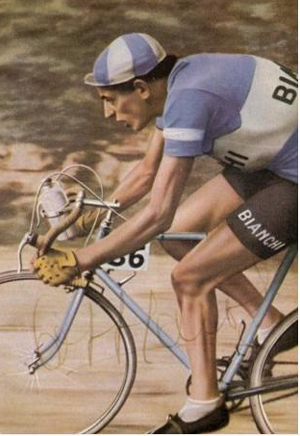Saddle too low?
 Tue, October 27, 2015
Tue, October 27, 2015  If I see someone riding with their knees splayed outward it is often a good indication that their saddle is too low.
If I see someone riding with their knees splayed outward it is often a good indication that their saddle is too low.
It may also be the rider is overweight and has a large belly to contend with, but not always.
Stand with your back to the wall and raise one knee forward and upwards towards your chest.
There is a limit to how high your thigh can go. Once that point is reached, the only way you can make your knee go higher is to move your knee outward and then it can travel an inch or two higher.
Squat with your knees together and you can’t go as low as you can with your knees spread apart. In non-medical terms, it is the limit of travel of the ball at the end of your thigh bone in its socket in the pelvis that restricts your movement beyond a certain point.
It amuses me to see riders with aero bars in a low horizontal tuck position, riding with knees splayed outwards. Any aerodynamic advantage they gain by the low tuck position is lost because the outward knees has increased their frontal area by 20% or more. Not only that, but the outward spread thighs is like an open ended “V” catching air as they travel forward.
In order to achieve a low horizontal position, one must be flexible enough that the pelvis remains near vertical and the back bone or spine bends forward. Three things affect the angle of the thigh bone in relation to the pelvis. The saddle too low, the saddle too far back, and the back too low, but only if it causes the pelvis to rotate forward.
It is rarely I see someone with their saddle too high. One can feel that they are stretching at the bottom of the pedal stroke, or they are rocking side to side on the saddle as they pedal. But a saddle too low may feel fine, but it is not necessarily the most efficient riding position.
If your knees are splaying outwards it should be easy to spot, just look down. Knees should pump straight up and down like two pistons, and should pass an inch or so either side of the top tube. If you suspect your saddle is too low, it rarely does any harm to raise it. Put a piece of masking tape around the seat post to mark the original position. Raise it by a small amount 1/8 in, or 1/4 in. Maximum. (3 mm. to 6mm.)
Ride for a week or so, then possibly you can go up a little more until you find the sweet spot. Saddle height is not a fixed thing. As you lose weight and muscles stretch a saddle needs to be raised. The questions you need to ask yourself after raising the saddle is, does it feel better, do I feel stronger, and am I going faster.
To reiterate, few ride with a saddle to high, but many ride with their saddle too low, because it feels fine. Unless you try raising it a little you will never find out. I feel any person’s ideal saddle height is the point where the saddle is almost too high, then down a tad from there.
The leg needs to reach its full extension at the bottom of the pedal stroke, without stretching to reach that point, in other words the power is on right to the end of the pedal stroke, and definitely not reach its upper limit at the top of the stroke.
Footnote: I couldn’t find a better picture to illustrate this piece, except the exaggerated one at the top. But it did lead me to realize how BMX riders manage to pedal straight with their saddle so low. The saddle nose is positioned up which causes the pelvis to lean back thus increasing the angle in relation to the thigh. I'm not suggesting you try this on your road bike.
To Share click "Share Article" below
 Dave Moulton | Comments Off |
Dave Moulton | Comments Off | 































